The Failed Assassination of Donald Trump
Dozens of photographers documented the attempt on the former President, but for better or worse, one photo has become iconic.
Doug Mills thought it was a car backfiring. Jabin Botsford and Anna Moneymaker thought it was fireworks. When Evan Vucci heard the pops over his left shoulder, he knew immediately it was gunfire. Regardless, without pause, all four photographers sprung into action.
At 6:11 p.m. July 13, 2024, former President Donald Trump was shot.
“I can’t hide. I can’t duck behind the stage. I have to do my job,” Vucci, a long-time staff photographer with the Associated Press, told The Washington Post. He maintained his composure and made a photo that will be revered—and reviled—for generations. It’s Vucci’s version of Joe Rosenthal’s triumphant and inspirational Raising the Flag on Iwo Jima…
Or, is it his version of Stanley Forman’s violent and disturbing Soiling of Old Glory?
I think it’s both, and that’s why Vucci’s photo is undoubtedly one of the most important, and revealing, in history.
But, unlike Rosenthal’s and Forman’s Pulitzer Prize-winning images, where only one frame of the iconic photo exists, there are several slightly different iterations of Vucci’s Failed Assassination of Donald Trump. Given the ubiquity of photos and photographers (e.g., everyone with a smartphone), that’s to be expected and why a singular iconic photo is so rare.
The details are exacting—the streaks of blood across Trump’s face, mouth agape, fist defiantly-raised, and, most obviously, the American flag against a 9/11-blue sky. The body language of the Secret Service agents gathered behind, pushing Trump forward, echoes the Marines wrestling the flag in Rosenthal’s photo. And despite surviving a gunshot, Trump still clings to his red MAGA hat.
The New York Times begrudgingly compared the iconic moment to Eugène Delacroix’s Liberty Leading the People. But if we’re talking visual analogues, given what happened just after Trump was grazed by an assassin’s bullet, I’d liken Vucci’s photo to The Resurrection of Christ by Boltraffio and Oggiono…
Say what you will about the death of print—Vucci’s photo on the cover of TIME, with its simple color palette accentuated by the blood-red border, cements its place in history. Twenty years from now, a worn copy of this issue will be a cherished (or despised) artifact, not a tweet or an Instagram post.
Vucci's Failed Assassination of Donald Trump, shared millions of times by high-profile conservative accounts (rarely credited) was inevitably hijacked—commercialized and memeified. A great example is this Trump C-note created by Barstool Sports’ Tate Moore…
And tattoos, like this one by by Hollywood, an artist in Canada…

Hollywood told me that he wasn’t surprised his client requested the Trump tattoo. “Images like that are so strong and become pop culture almost immediately,” he said. “I’m actually doing another one tonight, haha.”
Like Rosenthal’s photo, Vucci’s will one day be on a stamp.
An alternate frame by Vucci made the rounds too, lauded by The New Yorker as “an indelible portrait of our era of political crisis and conflict,” and The Washington Post called it a “powerful photograph that could change America forever.” But for me, the female agent’s raised arm is distracting and the agents behind Trump (mouth closed) are obscured. It’s quieter, less Rosenthal-esque.
Another alt-frame by Vucci fronted many of the big U.S. dailies, including the Chicago Tribune, The Boston Globe and the Los Angeles Times. For whatever reason—whether the photo editors deemed it too incendiary or emotionally manipulative with the entire flag in the frame, or if they were simply overwhelmed by the volume of photos and overlooked it—right moment, wrong photo.
Here are a few papers that got it right…
Side note: this wasn’t Vucci’s first time photographing an attack on an American president, though far less severe. On December 14, 2008, he photographed Iraqi journalist Muntader al-Zaidi hurling a shoe at President George W. Bush during a press conference in Baghdad.
New York Times staff photographer Doug Mills was standing just to the right of Vucci, and captured his own version of the iconic moment. Because he was holding his camera a few inches higher than Vucci, the flag is out of the frame. Still a hell of a photo…
The strength of Mills’ photo wasn’t lost on the profiteering Proud Patriots. Within days the Orlando-based online retailer created a trading card, for $29.99.
And a $2 bill, for $29.99.
In an interview with The New York Times, Mills described this second photo he made seconds later: “As tough as he looked in that one picture with his fist looking very defiant, the next frame I took, he looked completely drained. Very, very shocked.”
Mills was the only photographer to document a sequence of the attempted assassination, miraculously capturing a bullet whizzing past Trump’s ear.
“The moments right before the bullets rang out I was literally looking up at this huge flag that was up above him while he was speaking,” Mills told ABC News. “I thought, ‘ok I’m going to try and get some pictures of that flag flying’ and then he gestured to his right and looked over and all of the sudden the shots rang out.
“When I saw him fall behind the podium, I thought, ‘Oh dear God, he’s been shot.’”
Conspiracists are losing their mind over this photo, insinuating Mills had prior knowledge of the attempt. That nonsense aside, Mills’ sequence instantly reminded me of Ron Edmonds’ photos of the assassination attempt on President Reagan.
Turns out, Edmonds was Mills’ mentor at the AP back in the day and they often discussed the attempt on Reagan. “I distinctly remember him (Edmonds) saying, ‘I hope you never have to go through something like this,’”Mills recalled. “And here we are. Sadly, history has repeated itself.”
Jabin Botsford, a staff photographer for The Washington Post and a fellow Western Kentucky University alum, was standing just behind Mills and Vucci, also capturing the iconic moment.
Even more fascinating and unprecedented, Botsford documented the historic moment with Ray-Ban Meta Smart glasses, offering one of the most revealing, and intense, perspectives I’ve ever seen.
“It was super scary. Nobody knew what was going on,” Botsford told The Washington Post. “The president fell to the ground, and I was going to make a picture of it even though the staff was like, ‘You guys need to get down.’”
See the kneeling photographer at 0:03? That’s Anna Moneymaker, making a very important photo—more on that in a second. Vucci and Mills (in the bucket hat) are in front of Botsford, who, luckily, is 6’5”.
Mills’ and Botsford’s near-identical photos led their respective newspapers the following day.
Getty Images’ D.C.-based staffer, Anna Moneymaker, also captured the exact moment as Vucci—notice Trump’s open mouth and the female Secret Service agent bending down to pick up his MAGA hat.
“It was just surreal, confusing, and nothing like I’ve ever experienced before,” Moneymaker recounted in an interview with PBS.
Moneymaker was the only one to capture a photo of a bloodied Trump on the ground, blanketed by agents. Her photo is an antidote, a counterpoint, to the others—its importance cannot be understated.
“It’s all these blue suits, you could just see in that little archway of legs, like, his face,” Moneymaker said. “I didn’t notice blood at first…I just kept taking pictures.”
The four photographers—Vucci, Mills, Botsford, and Moneymaker—positioned around the stage in what the White House Press Corps calls the “buffer,” can be seen in this video from WBEN. The footage, taken by listener “Rich, from Angola,” shows exactly how the four photographers worked the attempted assassination, moving from right to left to capture the iconic moment on the stairs (0:42). Keep an eye out for Moneymaker making her way around the back of the stage.
The attempt was also documented by pool video cameras on the press riser, about 100 feet from the stage. A team of freelancers, led by Fox News producer James Levinson, captured the historic scene live—forever etched into history.
The footage from the second pool camera clearly shows the exact moment Vucci made the frame (1:31).
No doubt, Ron Edmonds would have been proud of them all.
There were also several still photographers on the riser net to the pool video cameras. It’s a completely different perspective, the range of expressions in the crowd is fascinating. Eric Lee, a photographer with The New York Times, made this photo. You’d never think a deadly shooting had just happened.
This version was taken by Rebecca Droke, freelancing for Agence France-Presse.
Droke was one of the only photographers to capture an image of the spectator who was killed.
The AP had a second photographer, Gene J. Puskar, stationed on the riser with a long lens. Puskar made a remarkable series of close-up photos of Trump’s wounds—one of which was boldly published by Libération, the French daily.
Vucci’s photo made a prominent appearance during Trump’s speech at the Republican National Convention. Milwaukee-based AP photographer Morry Gash made this meta moment as the former President spoke about the attempt.
In an interview with The New York Post, Trump offered his unique perspective on Vucci’s image. “A lot of people say it’s the most iconic photo they’ve ever seen,” the former President said. “They’re right and I didn’t die. Usually you have to die to have an iconic picture.”
Vucci has remained grounded about his iconic photo. “It's not really the single image that I made or anything like that. It's that I was able to do the job and not flinch,” he told PBS. “I'm just proud that I didn't mess it up.”


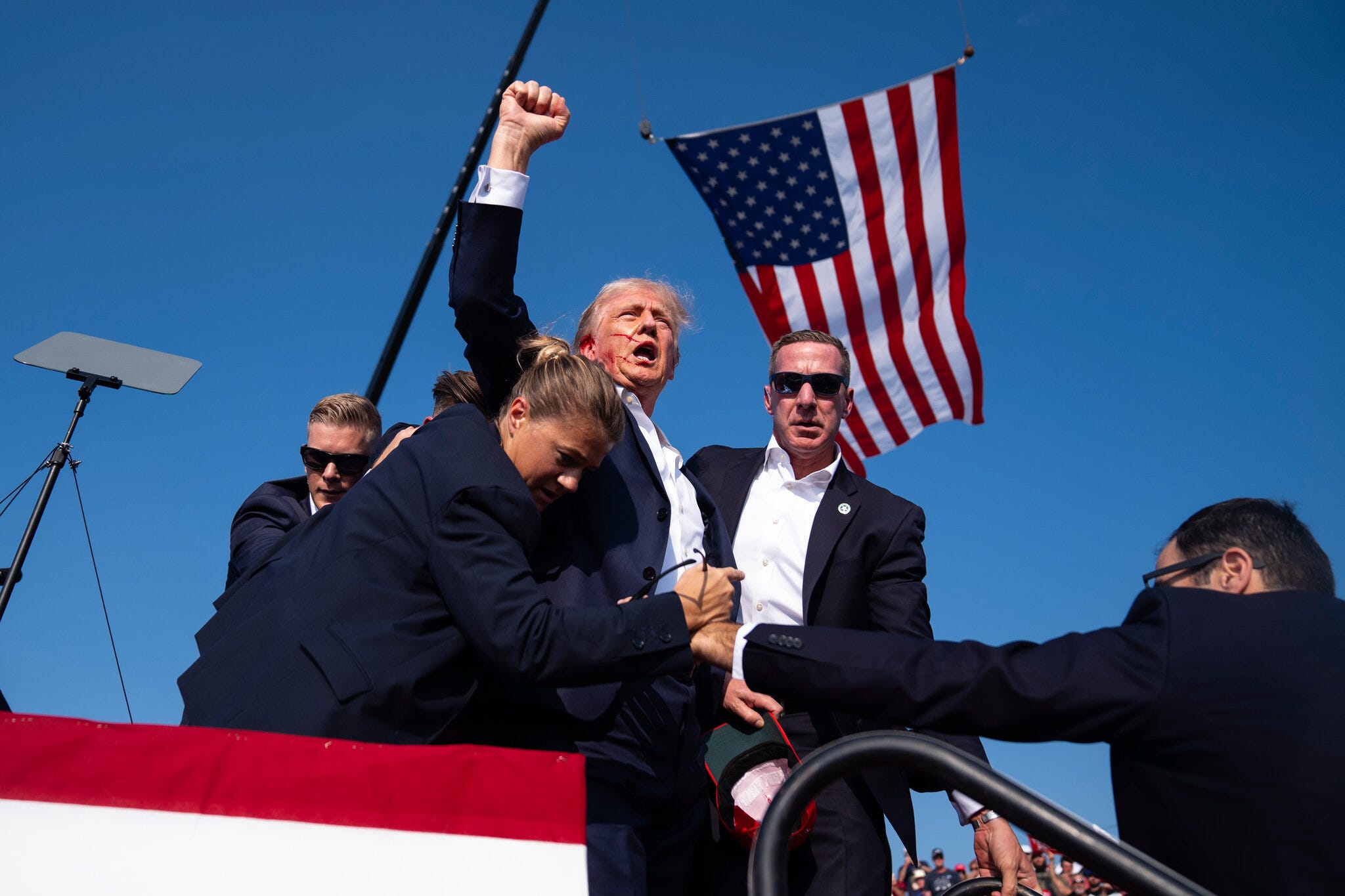
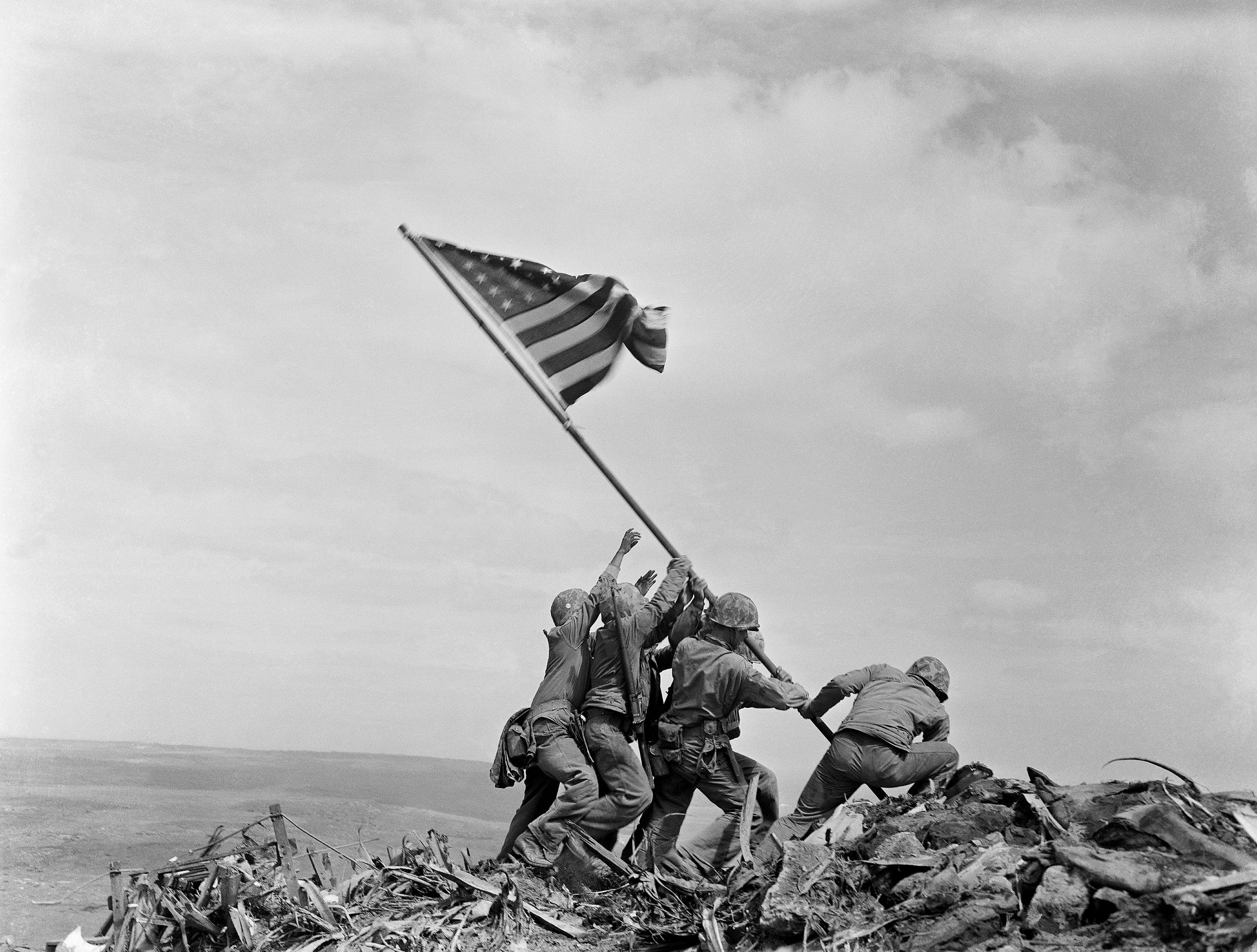

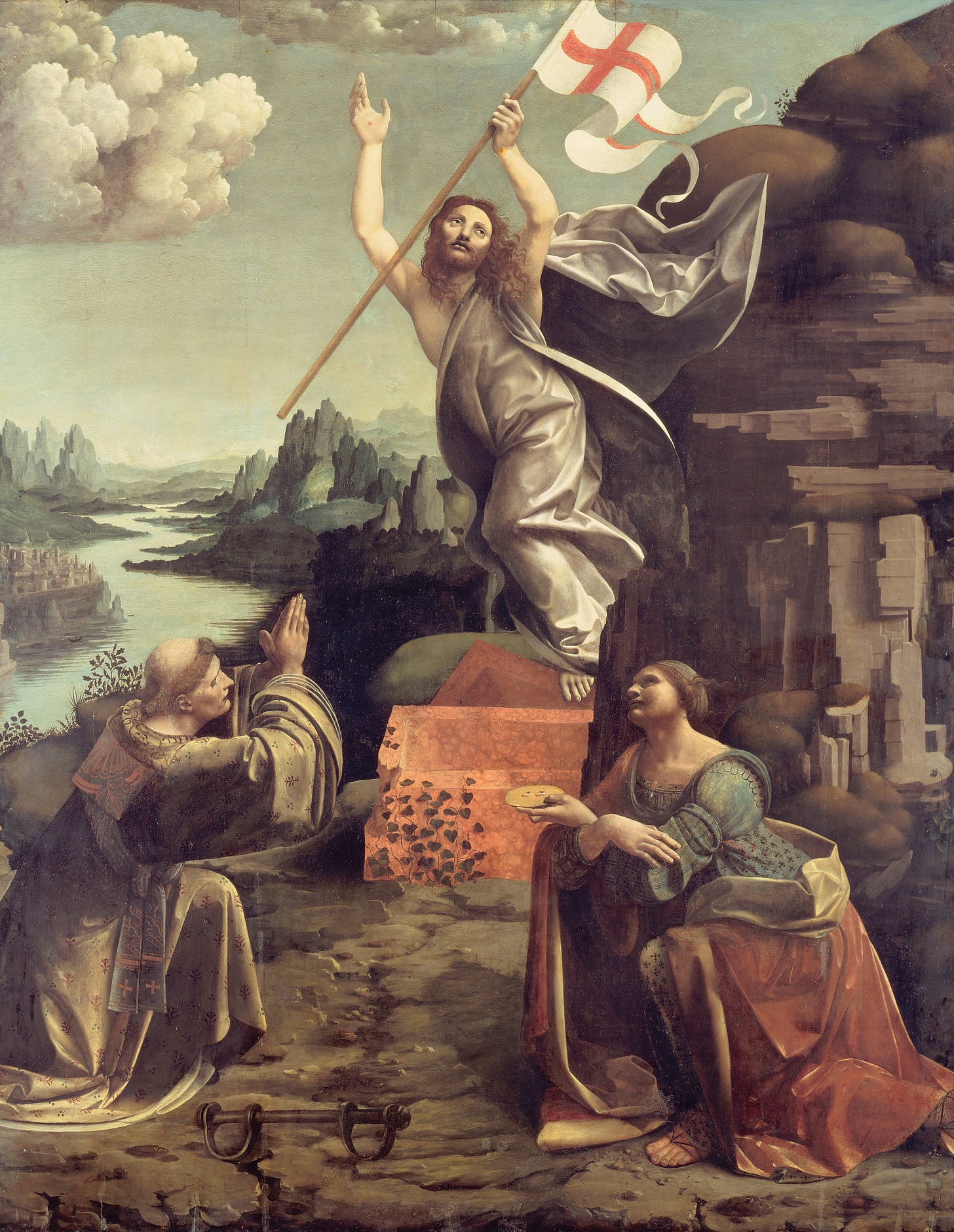
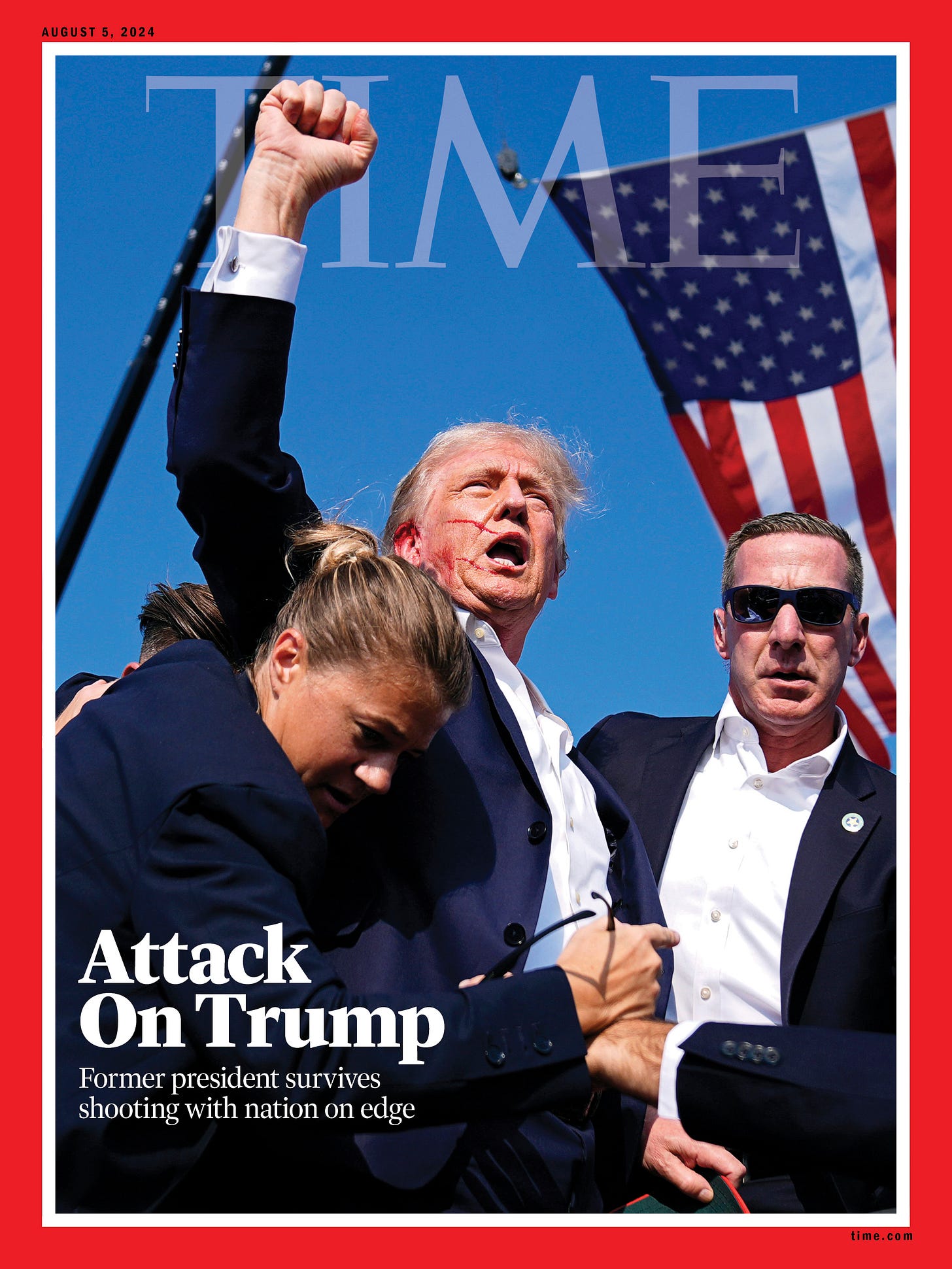


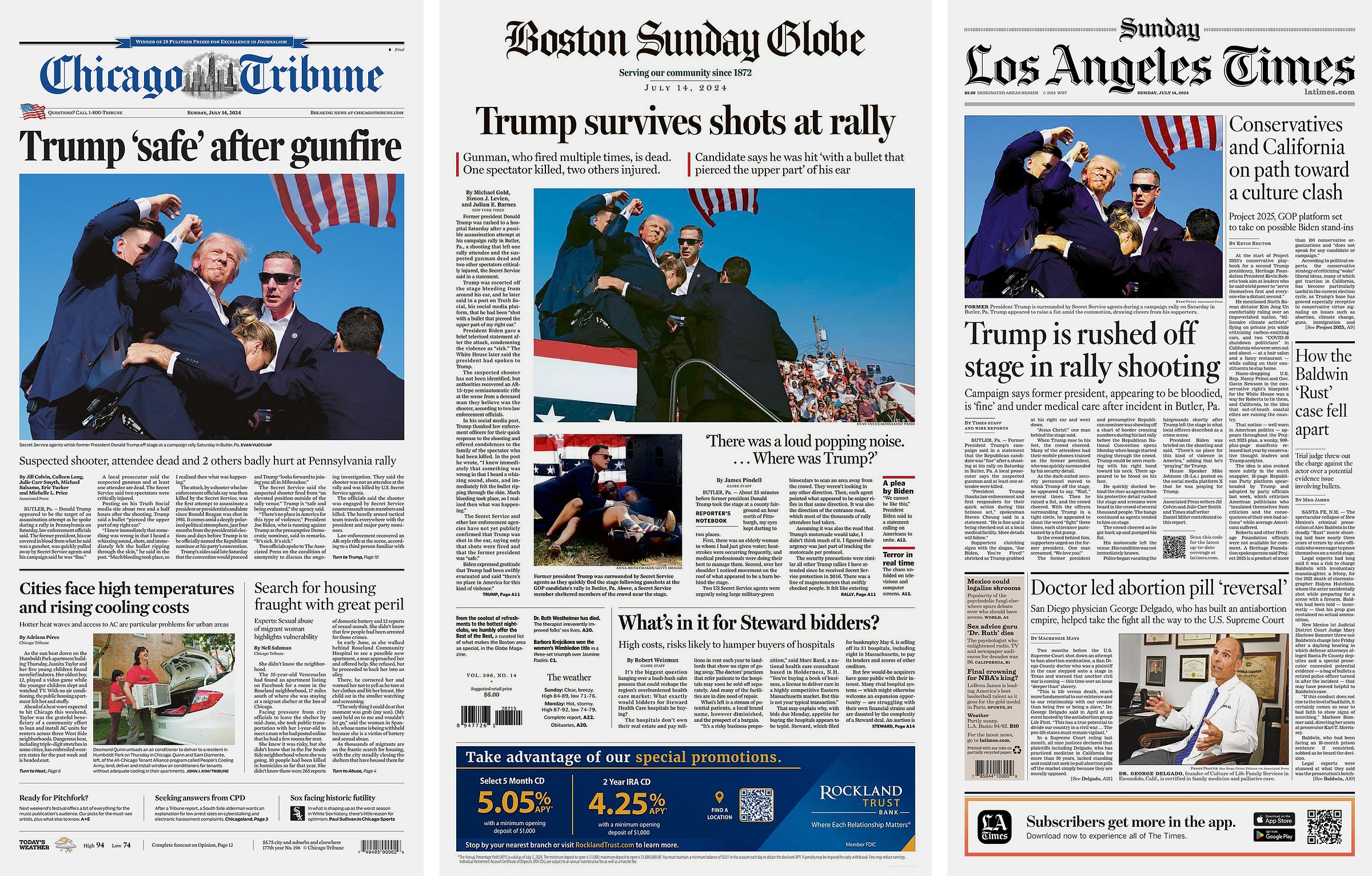






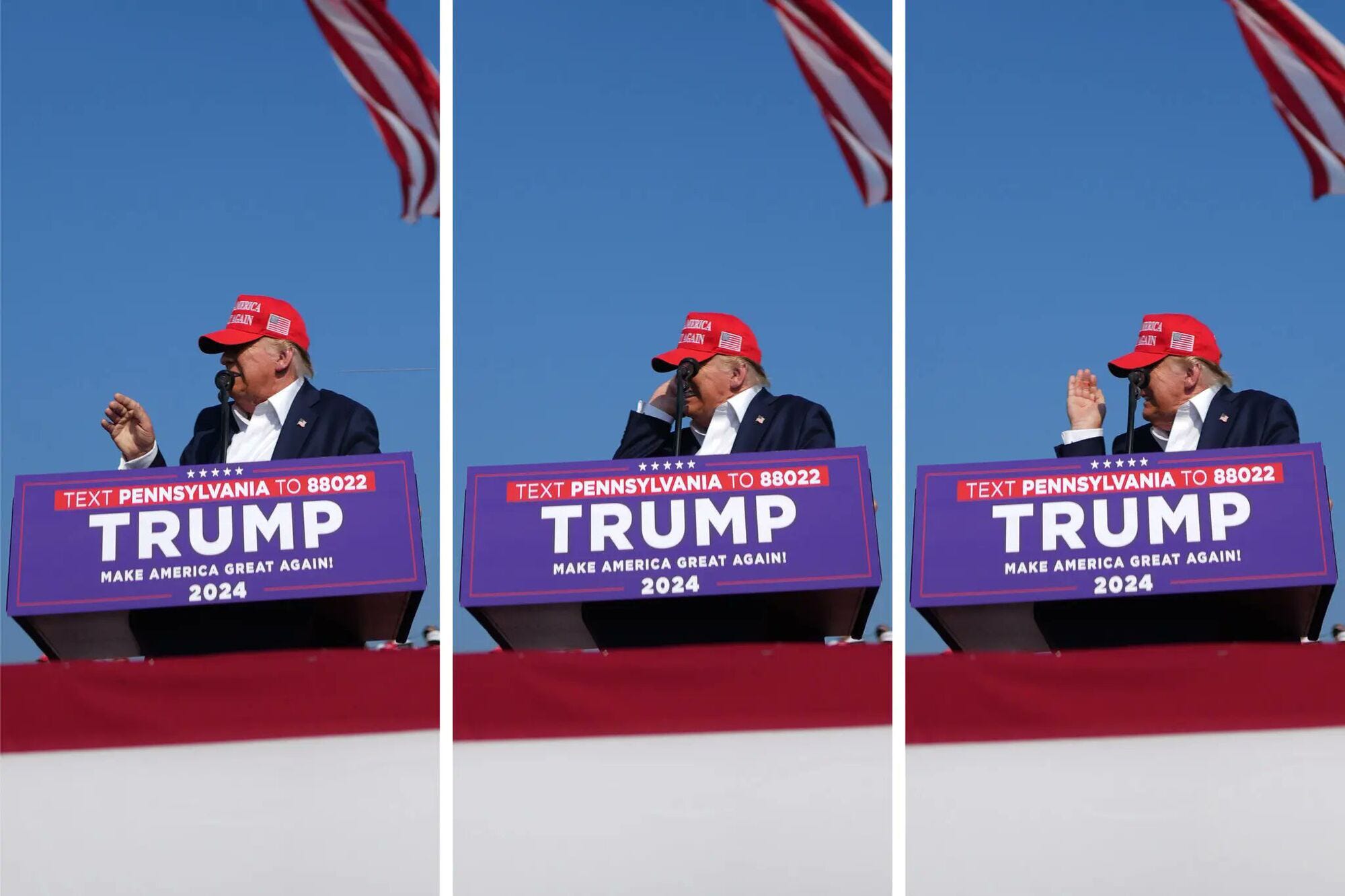

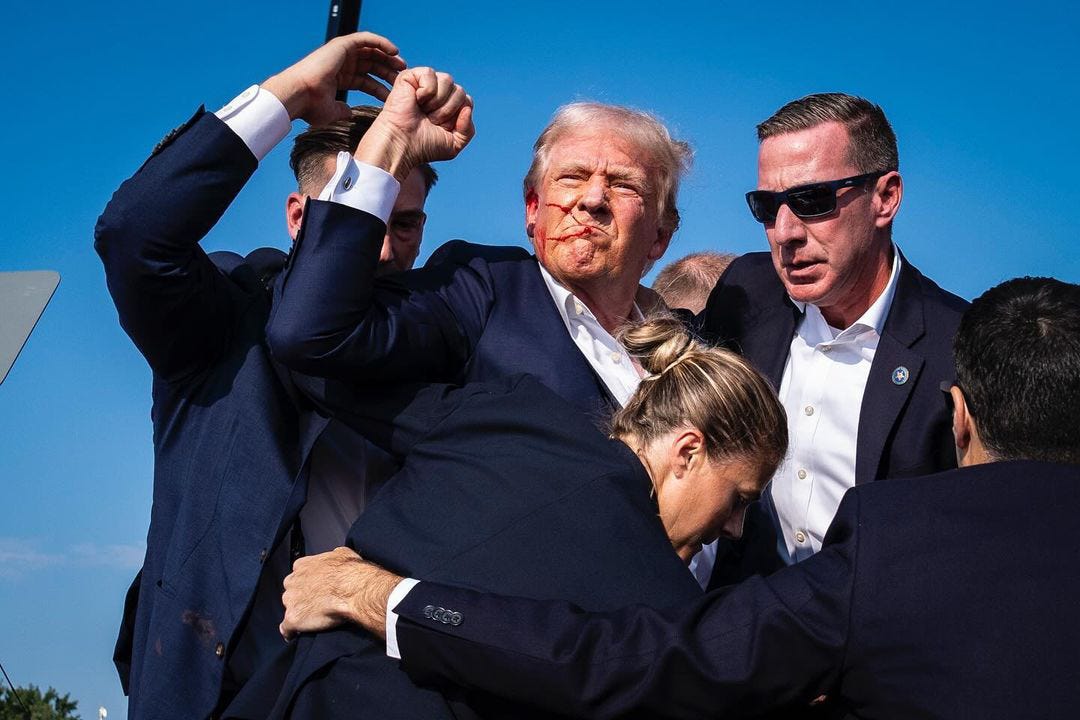
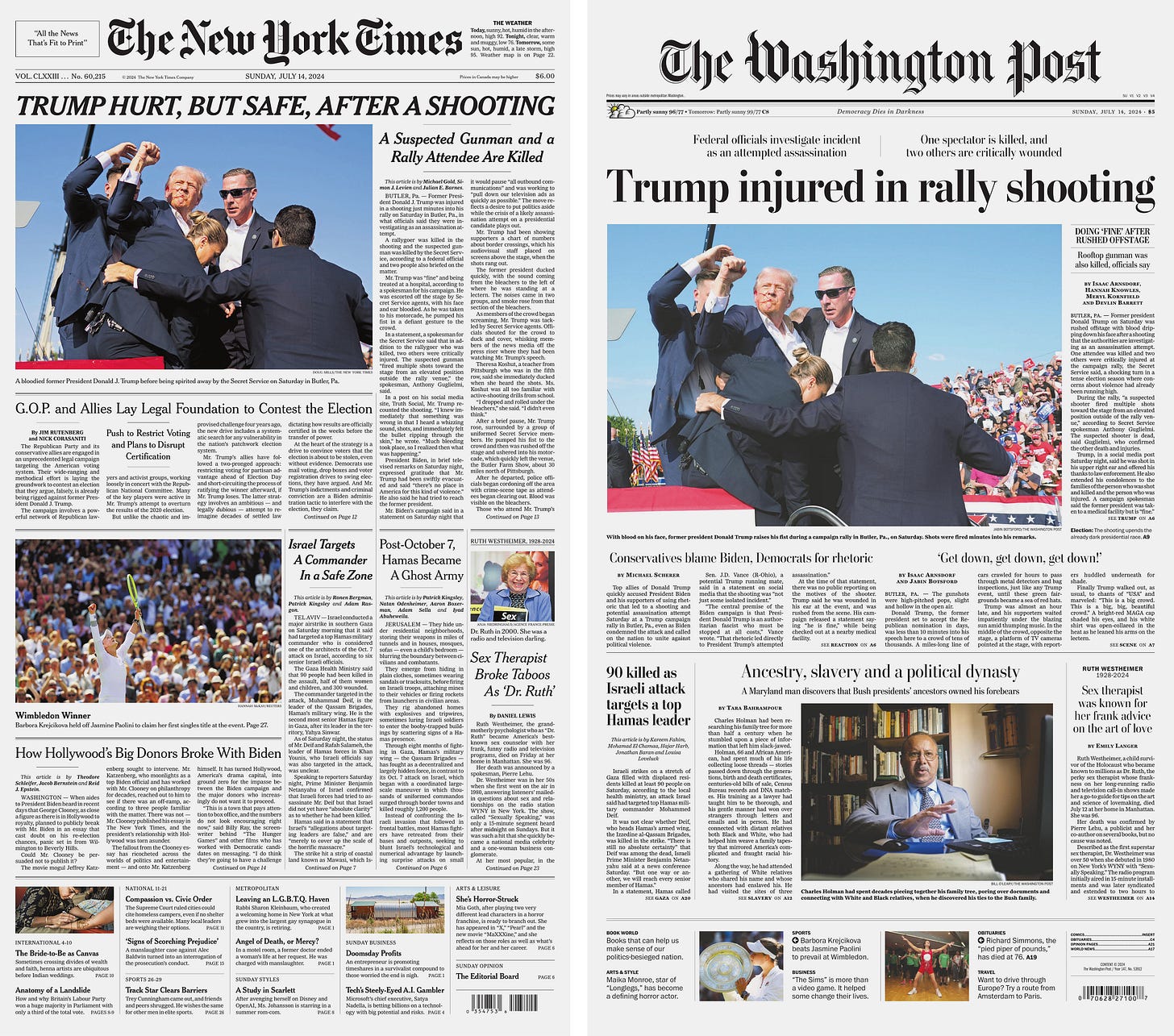

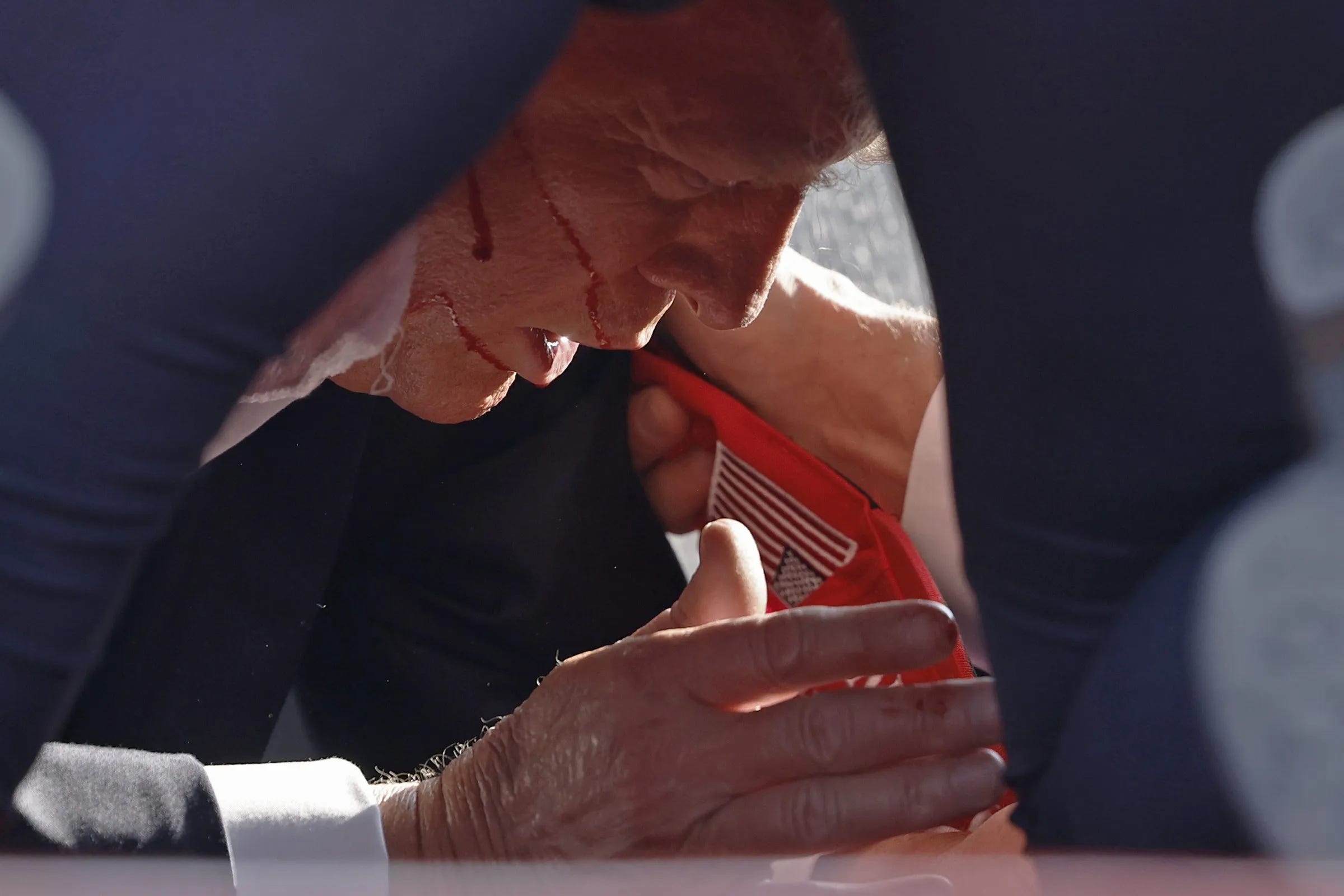
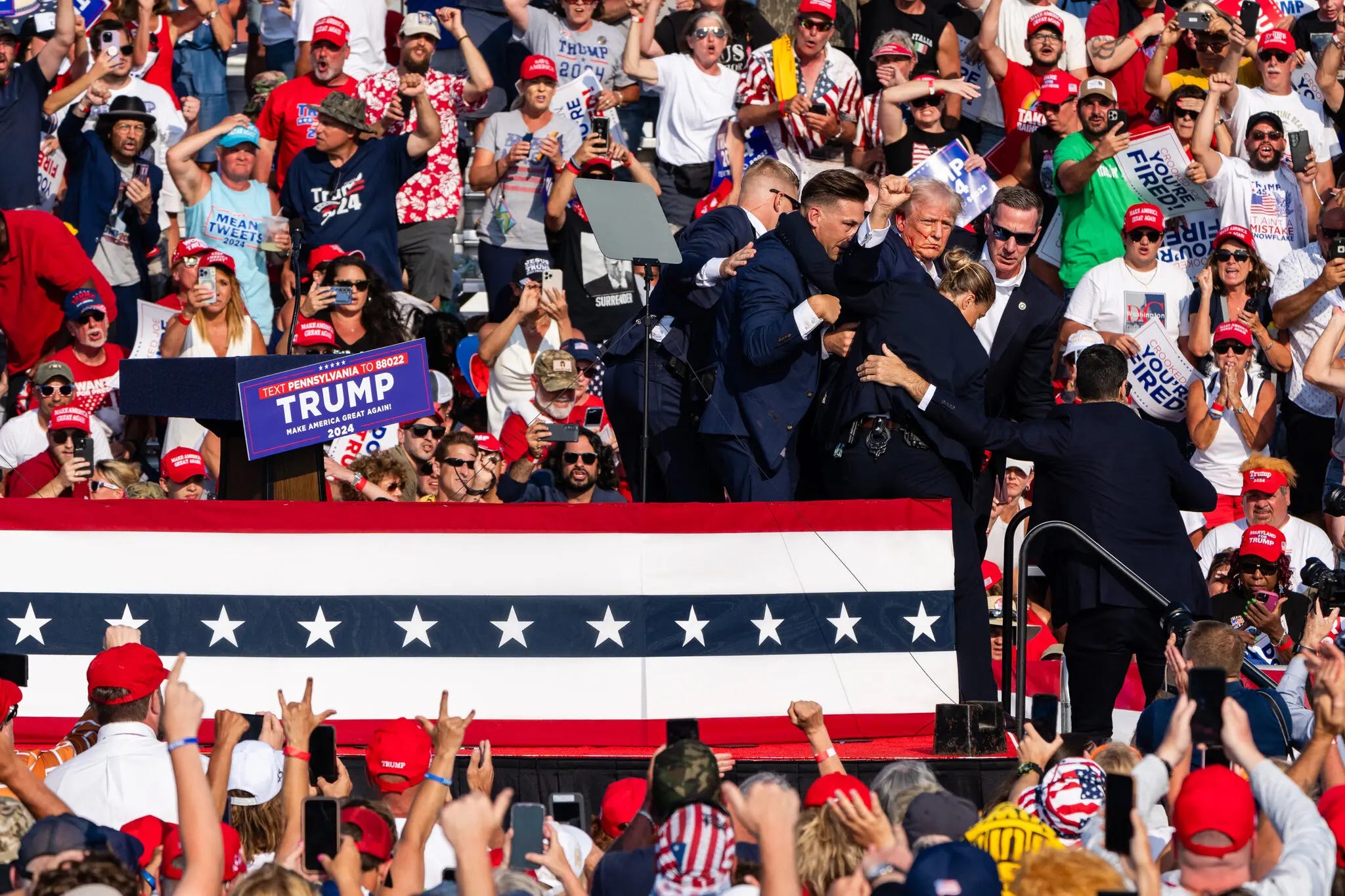
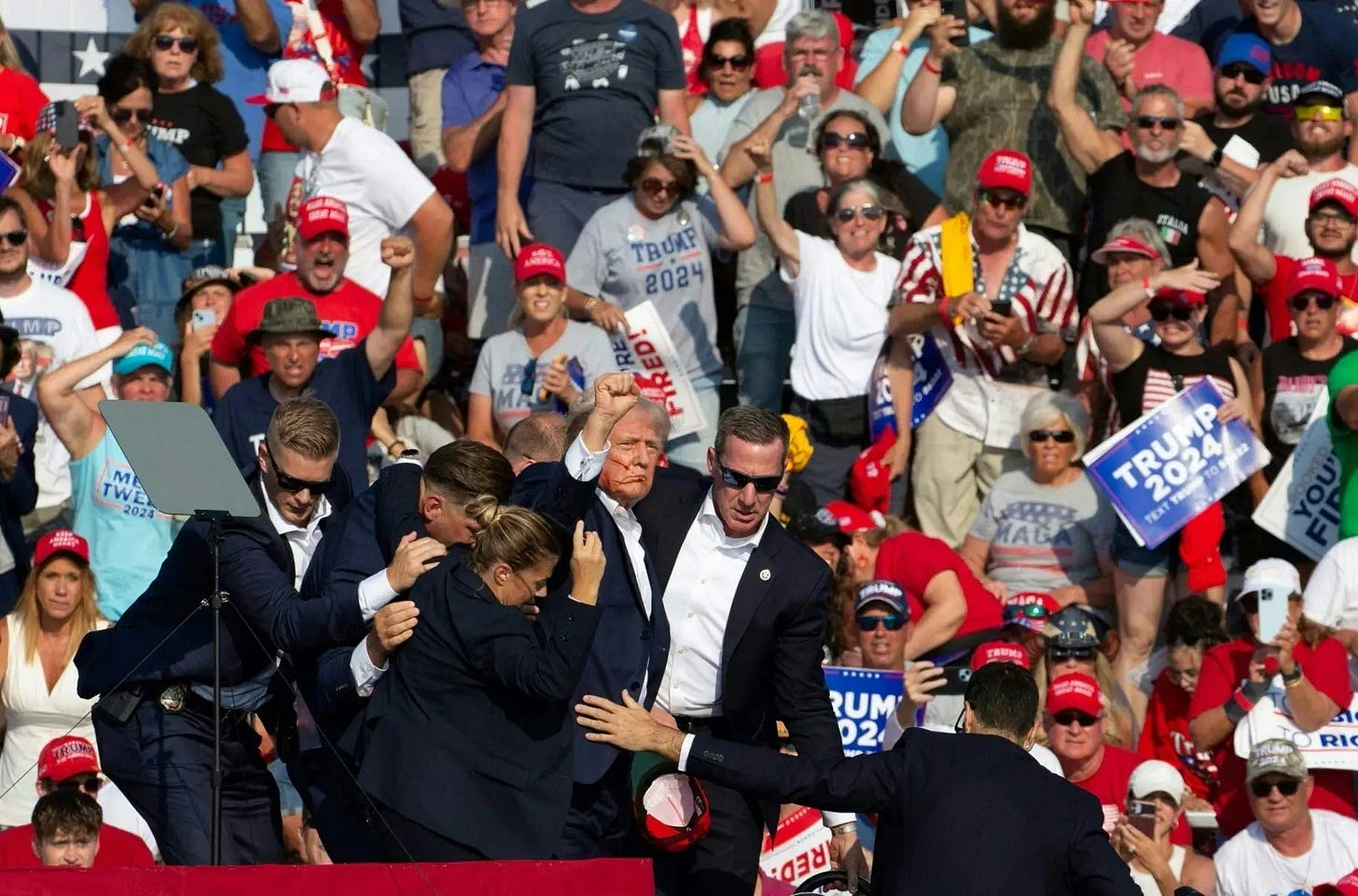
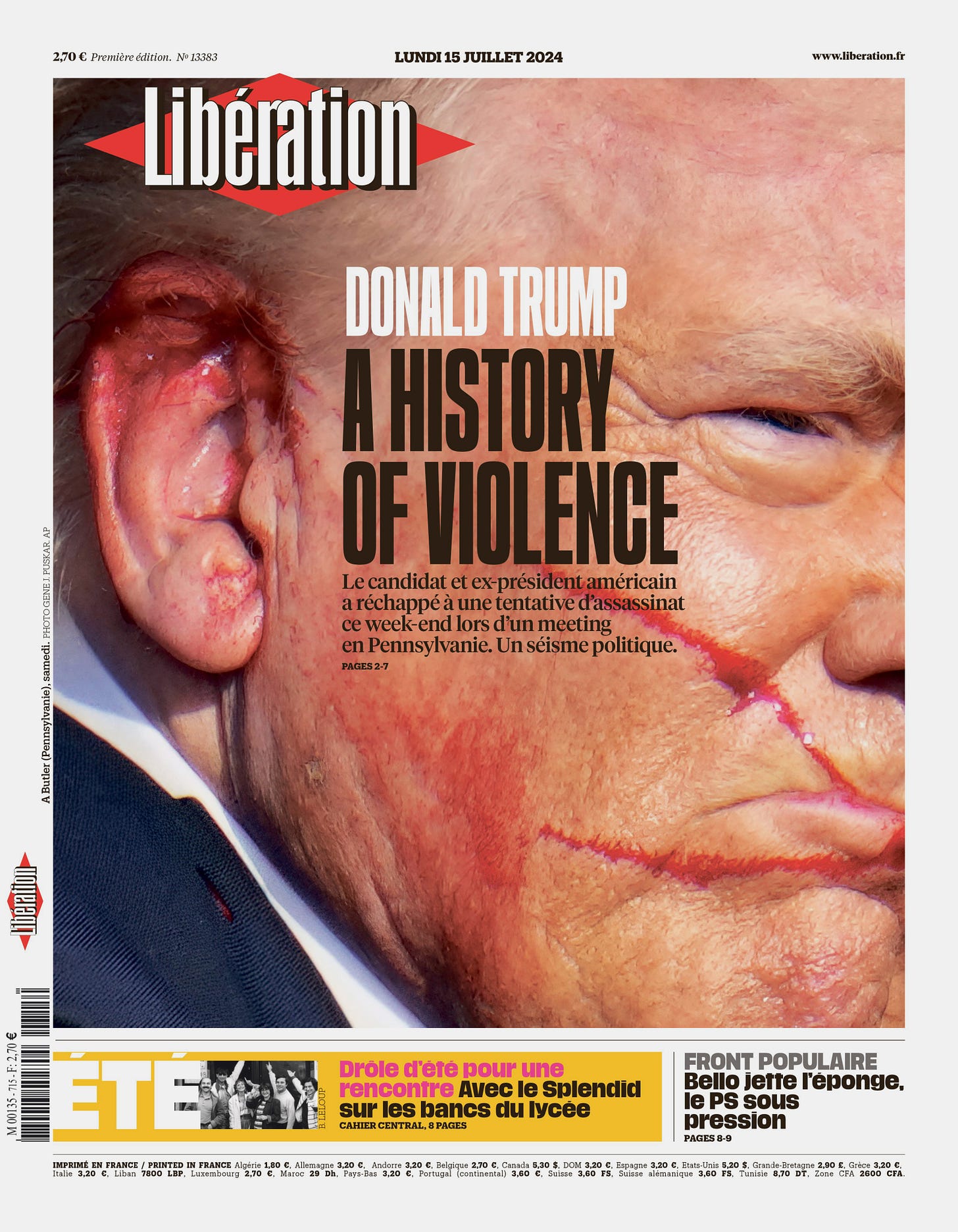
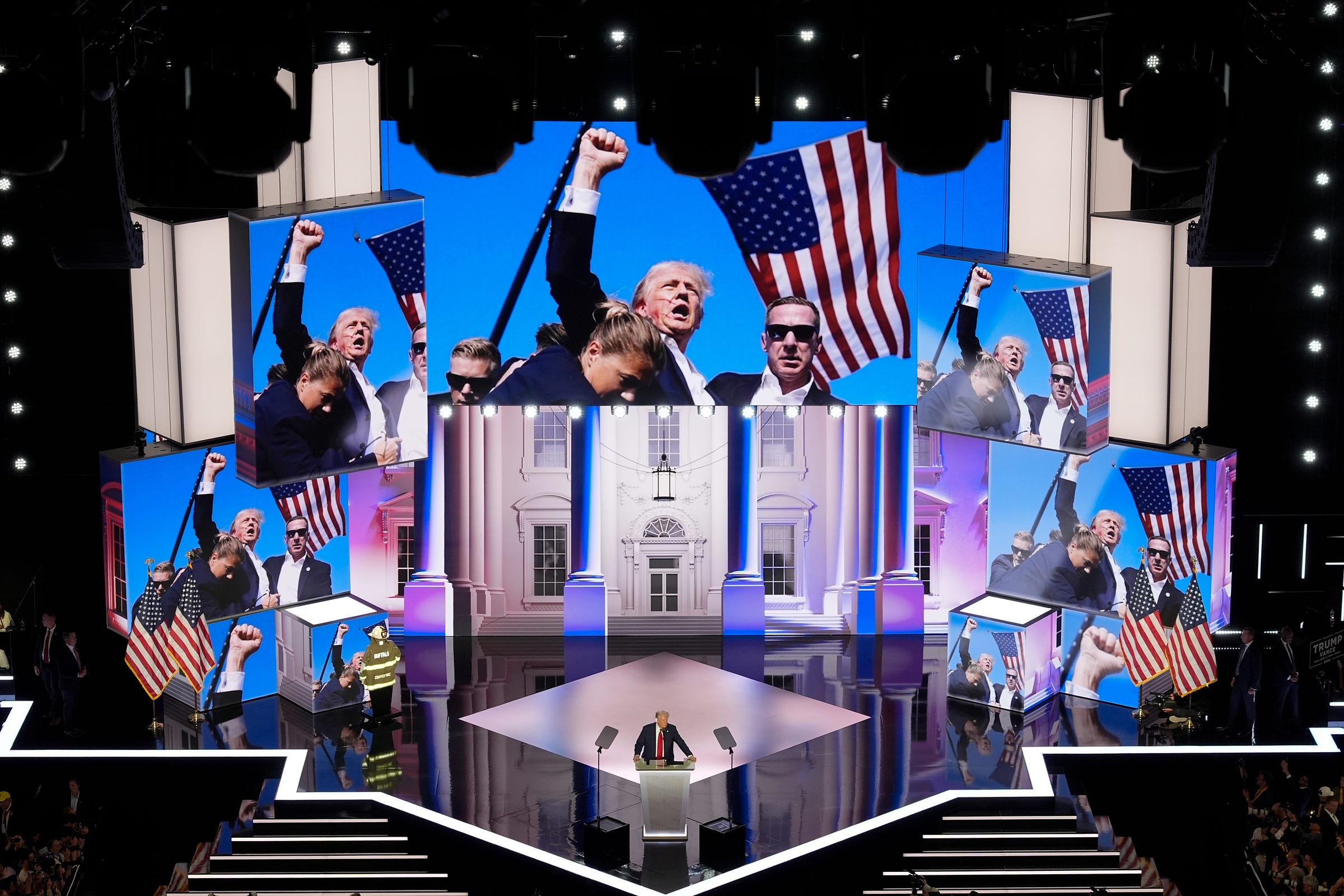

A detail of Vucci’s photo that I haven’t seen mentioned is that the flag has the vague appearance of flying upside down, adding another layer of symbolism. I understand it is actually being flown sideways, but the angle of the one visible supporting pole and the flag’s distance from it almost make it look as if it is falling upside down from it.
You are by far my favorite read on Substack. Marvelous work here, again. Thanks